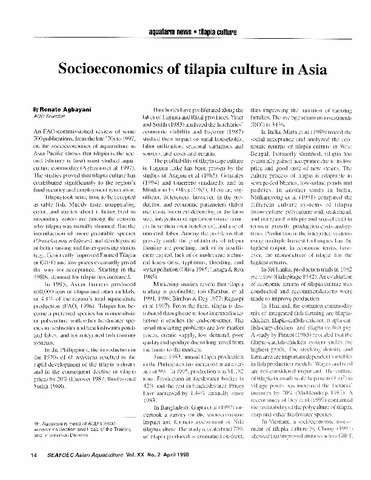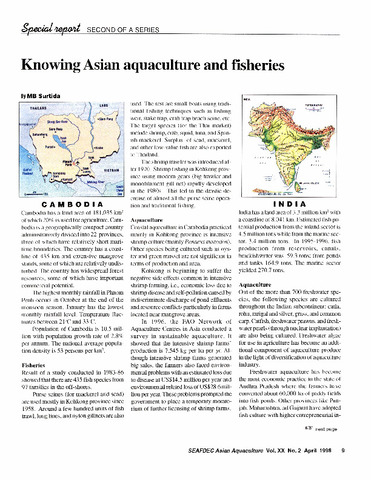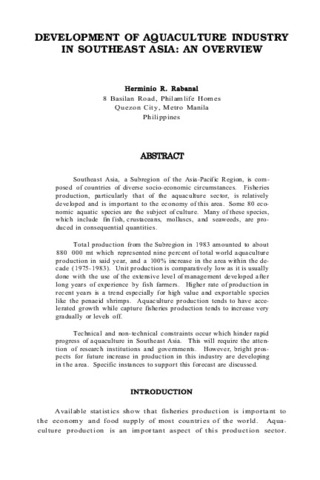Aquaculture economics in Asia and the Pacific: A regional assessment
- Global styles
- MLA
- Vancouver
- Elsevier - Harvard
- APA
- Help
Download URL
www.fao.orgDate
1997Page views
4,373ASFA keyword
AGROVOC keyword
Metadata
Show full item record
Share
Abstract
A broad overview is given of research and information on aquaculture economics in Asia and the Pacific. Following a description of the general state of aquaculture in the region, an examination is made of the available research and information on the various aquaculture systems: inland/freshwater aquaculture; brackishwater /coastal aquaculture; and, marine aquaculture/sea farming. Studies on post-harvest handling, processing, transportation and marketing, and market analysis and development are discussed. Environmental issues and concerns, social equity and women's issues, community-based coastal resources management, technology transfer and macro-economic policies and institutional structures are also analysed. Aquaculture economics research is also assessed, highlighting thrusts, priorities, constraints and needs.
Description
As aquaculture expands in importance globally, there is an increasing need for corresponding economic information, to aid managers, policy-makers and planners. This document seeks to provide a review of the current state of this aquaculture economics information and research base in developing countries, based on a comprehensive compilation of available literature on the subject. A broad integrated view is adopted, encompassing micro- and macro-economics, market analysis, socio-economics and environmental economics, the relationship with non-aquaculture economic activities (household economics), as well as relevant socio-cultural considerations. The circular contains two principal components. First, there is a set of regional assessments (Africa and the Middle East, Latin America and the Caribbean, Asia and the Pacific) reviewing the economics of aquaculture activity, the state of the art in aquaculture economics research, and research priorities for the future, on a region-by-region basis. Second, a set of annotated bibliographies is provided, one for each of the three regions, together with a bibliography of general references. In total, 1 154 references are included: 77 General; 223 for Africa and the Middle East; 133 for Latin America and the Caribbean; and 721 for Asia and the Pacific. Each bibliography documents available literature on the economics of aquaculture systems, emphasizing the most recent literature but also including older literature as relevant to the current state of aquaculture. All bibliographies are indexed according to country, aquatic species, production environment, production system and eight economic subject areas.
Suggested Citation
Agbayani, R.F, Belleza, E.T., & Agbayani, E.C. (1997). Aquaculture economics in Asia and the Pacific: A regional assessment. In: A.T. Charles, R.F. Agbayani, E.C. Agbayani, M. Agueero, E.T. Belleza, E. Gonzales, B. Stomal, & J.-Y. Weigel (Eds.). Aquaculture economics in developing countries: regional assessments and an annotated bibliography (pp. 35-80). Rome: FAO.
Type
Book chapterSeries
Aquaculture economics in developing countries: regional assessments and an annotated bibliographyCollections
- Books and Book Chapters [123]
Related items
Showing items related by title, author, creator and subject.
-
Socioeconomics of tilapia culture in Asia
Agbayani, Renato F. (Aquaculture Department, Southeast Asian Fisheries Development Center, 1998) -
Knowing Asian aquaculture and fisheries
Surtida, Marilyn B. (Aquaculture Department, Southeast Asian Fisheries Development Center, 1998-04)This article is the second of four parts. -
Development of aquaculture industry in Southeast Asia: An overview
Rabanal, Herminio R. (Aquaculture Department, Southeast Asian Fisheries Development Center, 1988)Southeast Asia, a Subregion of the Asia-Pacific Region, is composed of countries of diverse socio-economic circumstances. Fisheries production, particularly that of the aquaculture sector, is relatively developed and is ...




